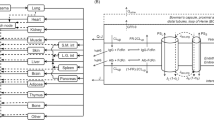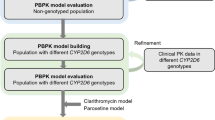Abstract
Background
Ixazomib is the first oral, proteasome inhibitor to reach phase III trials. Here, we present an integrated nonclinical and clinical assessment of ixazomib’s effect on QTc intervals.
Methods
Nonclinical studies assessed (1) the in vitro binding of ixazomib to the hERG channel and (2) its effect on QT/QTc in dogs (N = 4) via telemetry. Pharmacokinetic-matched triplicate electrocardiograms were collected in four clinical phase I studies of intravenous (0.125–3.11 mg/m2, N = 125, solid tumors/lymphoma) or oral (0.24–3.95 mg/m2, N = 120, multiple myeloma) ixazomib. The relationship between ixazomib plasma concentration and heart rate (HR)-corrected QT using Fridericia (QTcF) or population (QTcP) methods was analyzed using linear mixed-effects models with fixed effects for day and time.
Results
In vitro binding potency for ixazomib to the hERG channel was weak (K i 24.9 μM; IC50 59.6 μM), and nonclinical telemetry studies showed no QT/QTc prolongation at doses up to 4.2 mg/m2. In cancer patients, ixazomib, when evaluated at doses yielding various plasma concentrations (with 26 % of data greater than mean C max for the 4 mg phase 3 dose), had no meaningful effect on QTc based on model-predicted mean change in QTcF/QTcP from baseline. There was no relationship between ixazomib concentration and RR, suggesting no effect on HR.
Conclusions
Ixazomib has no clinically meaningful effects on QTc or HR. Integrating preclinical data and concentration–QTc modeling of phase 1 data may obviate the need for a dedicated QTc study in oncology. A framework for QT assessment in oncology drug development is proposed.



Similar content being viewed by others
References
Kupperman E, Lee EC, Cao Y et al (2010) Evaluation of the proteasome inhibitor MLN9708 in preclinical models of human cancer. Cancer Res 70:1970–1980
Chauhan D, Tian Z, Zhou B et al (2011) In vitro and in vivo selective antitumor activity of a novel orally bioavailable proteasome inhibitor MLN9708 against multiple myeloma cells. Clin Cancer Res 17:5311–5321
Lee EC, Fitzgerald M, Bannerman B et al (2011) Antitumor activity of the investigational proteasome inhibitor MLN9708 in mouse models of B-cell and plasma cell malignancies. Clin Cancer Res 17:7313–7323
Assouline SE, Chang J, Cheson BD et al (2014) Phase 1 dose-escalation study of IV ixazomib, an investigational proteasome inhibitor, in patients with relapsed/refractory lymphoma. Blood Cancer J 4:e251
Kumar SK, Bensinger WI, Zimmerman TM et al (2014) Weekly dosing of the investigational oral proteasome inhibitor ixazomib in relapsed/refractory multiple myeloma: results from a phase 1 study. Blood 124(7):1047–1055
Richardson PG, Baz R, Wang M et al (2014) Phase 1 study of twice-weekly ixazomib, an oral proteasome inhibitor, in relapsed/refractory multiple myeloma patients. Blood 124:1038–1046
Smith PC, Infante JR, Siu LL et al (2011) 1210 POSTER Phase 1 Study of MLN9708, an Investigational Proteasome Inhibitor, in advanced nonhematologic malignancies-updated results. Eur J Cancer 47:652–663
Gupta N, Zhao Y, Hui AM, Esseltine DL, Venkatakrishnan K (2014) Switching from body surface area-based to fixed dosing for the investigational proteasome inhibitor ixazomib: a population pharmacokinetic analysis. Br J Clin Pharmacol 79(5):789–800
Health Canada Guide for the analysis and review of QT/QTc interval data. 31 March 2010
VOTRIENT® (pazopanib) tablets. Full prescribing information. November 2013
TASIGNA® (nilotinib) capsules. Full prescribing information. January 2014
TYKERB® (lapatinib) tablets. Full prescribing information. October 2013
CAPRELSA® (vandetanib) tablets. Full prescribing information. March 2014
Bagnes C, Panchuk PN, Recondo G (2010) Antineoplastic chemotherapy induced QTc prolongation. Curr Drug Saf 5:93–96
Bello CL, Mulay M, Huang X et al (2009) Electrocardiographic characterization of the QTc interval in patients with advanced solid tumors: pharmacokinetic–pharmacodynamic evaluation of sunitinib. Clin Cancer Res 15:7045–7052
Sereno M, Brunello A, Chiappori A et al (2008) Cardiac toxicity: old and new issues in anti-cancer drugs. Clin Transl Oncol 10:35–46
Shah RR, Morganroth J, Shah DR (2013) Cardiovascular safety of tyrosine kinase inhibitors: with a special focus on cardiac repolarisation (QT interval). Drug Saf 36:295–316
Strevel EL, Ing DJ, Siu LL (2007) Molecularly targeted oncology therapeutics and prolongation of the QT interval. J Clin Oncol 25:3362–3371
Tolcher AW, Appleman LJ, Shapiro GI et al (2011) A phase I open-label study evaluating the cardiovascular safety of sorafenib in patients with advanced cancer. Cancer Chemother Pharmacol 67:751–764
Haverkamp W, Breithardt G, Camm AJ et al (2000) The potential for QT prolongation and pro-arrhythmia by non-anti-arrhythmic drugs: clinical and regulatory implications. Report on a Policy Conference of the European Society of Cardiology. Cardiovasc Res 47:219–233
Li EC, Esterly JS, Pohl S, Scott SD, McBride BF (2010) Drug-induced QT-interval prolongation: considerations for clinicians. Pharmacotherapy 30:684–701
Darpo B, Nebout T, Sager PT (2006) Clinical evaluation of QT/QTc prolongation and proarrhythmic potential for nonantiarrhythmic drugs: the International Conference on Harmonization of Technical Requirements for Registration of Pharmaceuticals for Human Use E14 guideline. J Clin Pharmacol 46:498–507
Liu Q, Madabushi R, Garnett C, Booth B (2008) Experience in QT evaluation of oncology drug products since ICH E14 guidance. J Clin Oncol 26(15S):2554
Darpo B, Sarapa N, Garnet C, Benson C, Dota C, Ferber G (2014) The IQ-CSRC Prospective Clinical Phase 1 Study: “Can Early QT Assessment Using Exposure Response Analysis Replace the Thorough QT Study?”. Ann Noninvasive Electrocardiol 19:70–81
Rock EP, Finkle J, Fingert HJ et al (2009) Assessing proarrhythmic potential of drugs when optimal studies are infeasible. Am Heart J 157(827–36):836
Malik M, Farbom P, Batchvarov V, Hnatkova K, Camm AJ (2002) Relation between QT and RR intervals is highly individual among healthy subjects: implications for heart rate correction of the QT interval. Heart 87:220–228
Yano Y, Beal SL, Sheiner LB (2001) Evaluating pharmacokinetic/pharmacodynamic models using the posterior predictive check. J Pharmacokinet Pharmacodyn 28:171–192
Redfern WS, Carlsson L, Davis AS et al (2003) Relationships between preclinical cardiac electrophysiology, clinical QT interval prolongation and torsade de pointes for a broad range of drugs: evidence for a provisional safety margin in drug development. Cardiovasc Res 58:32–45
Acknowledgments
The authors would like to thank the patients, their families and caregivers, and the healthcare professionals who participated in the C16001, C16002, C16003, and C16004 studies. The authors would also like to acknowledge Jane Saunders, a medical writer with FireKite, part of KnowledgePoint360, an Ashfield company, for writing support during the development of this manuscript, which was funded by Millennium Pharmaceuticals, Inc.
Author information
Authors and Affiliations
Corresponding author
Ethics declarations
Financial support
This work was funded by Millennium Pharmaceuticals, Inc., a wholly owned subsidiary of Takeda Pharmaceutical Company Limited.
Conflict of interest
NG, SO, A-MH, and KV are employees of Millennium Pharmaceuticals, Inc., a wholly owned subsidiary of Takeda Pharmaceutical Company Limited. YM and MMH have received research funding from Millennium Pharmaceuticals, Inc., a wholly owned subsidiary of Takeda Pharmaceutical Company Limited.
Informed consent
Informed consent was obtained from all individual participants enrolled in the studies included in the analysis.
Ethical approval
All procedures performed in studies involving human participants were in accordance with the ethical standards of the institutional and/or national research committee and with the 1964 Helsinki declaration and its later amendments or comparable ethical standards.
Electronic supplementary material
Below is the link to the electronic supplementary material.
Rights and permissions
About this article
Cite this article
Gupta, N., Huh, Y., Hutmacher, M.M. et al. Integrated nonclinical and clinical risk assessment of the investigational proteasome inhibitor ixazomib on the QTc interval in cancer patients. Cancer Chemother Pharmacol 76, 507–516 (2015). https://doi.org/10.1007/s00280-015-2815-7
Received:
Accepted:
Published:
Issue Date:
DOI: https://doi.org/10.1007/s00280-015-2815-7




